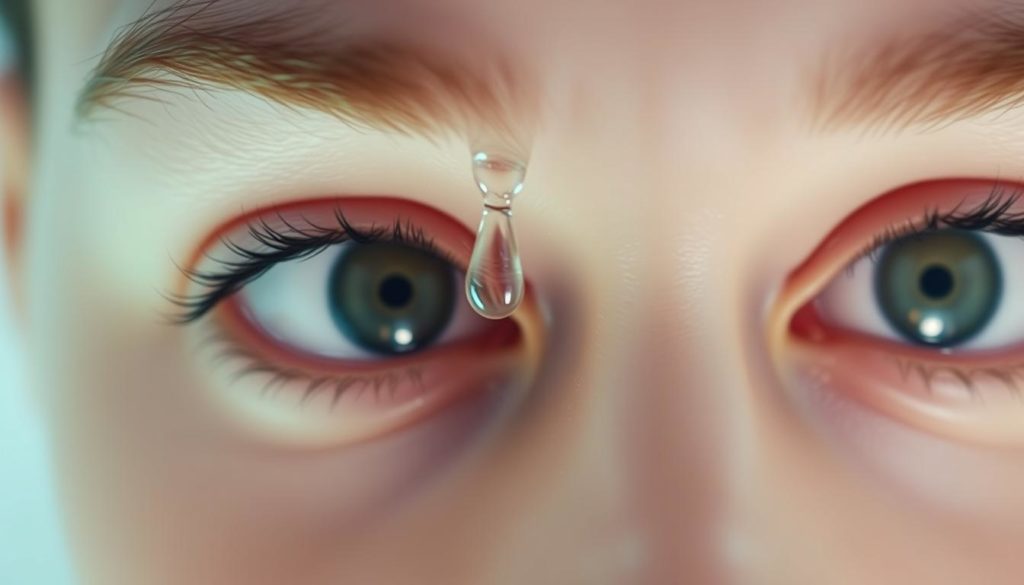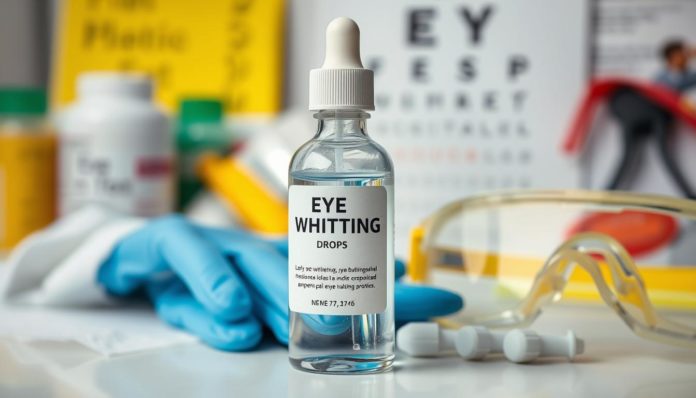Did you know almost 50% of Americans face red eyes from allergies or too much screen time? Eye-whitening drops may seem like an easy solution for bright eyes. But, there’s more to think about than just their quick effects.
The American Academy of Ophthalmology (AAO) notes red eyes could mean serious health issues. Eye-whitening drops can make eyes look clearer by narrowing blood vessels. Yet, they come with risks of eye whitening drops like rebound redness and harmful preservatives. Ophthalmologist Amy Lin from the John A. Moran Eye Center says it’s important to use them in moderation. Knowing how to safely use eye-whitening drops is key to keeping your eyes healthy.
Think twice before using those drops. Learn how to use them right and find other ways to maintain healthy, white eyes without risking your sight.
Understanding Eye-Whitening Drops
Eye-whitening drops are a quick way to reduce redness in the eyes. They work by shrinking the tiny blood vessels. This makes your eyes look whiter. Fashion gurus often talk about these drops. They note the special blue tints in some formulas that reduce yellow tones.

But, it’s key to know the side effects of these drops. Eye specialist Amy Lin points out regular use might cause skin color changes around the eyes. It can also stain clothes and contacts. This info is crucial for how to use eye whitening drops properly. While useful for looks, it’s best to use them in moderation to dodge problems.
Eating well and getting enough sleep is a better way to keep eyes healthy, say eye experts. These natural methods are safer and last longer than often using eye-whitening drops.
What Causes Red Eyes and How Eye-Whitening Drops Help
Red eyes can be annoying, often due to many reasons. Knowing why helps you manage and relieve them well.

Common Causes of Red Eyes
Allergies, long hours in contact lenses, and elements like smoke or wind often cause red eyes. Too much screen time can make it worse. The American Academy of Ophthalmology notes, sometimes, red eyes signal deeper health problems.
How Eye-Whitening Drops Work
Eye-whitening drops lighten red eyes by shrinking blood vessels. Yet, they’re a short fix, not solving the real issue. For healthy eyes, find and treat the cause of redness, not just hide it with drops.
Best Eye Drops for Whitening: What to Look For
Looking for the best eye drops for whitening? Focus on key ingredients and trusted brands to find safe and effective options. It’s also vital to know the risks of eye whitening drops and follow safety guidelines for eye brightening drops.
Key Ingredients to Consider
Eye whitening drops vary. Here are some ingredients to consider:
- Brimonidine: Great for targeting smaller veins, it luckily causes less rebound redness than older remedies.
- Tetrahydrozoline: Though good for arteries, it has a higher chance of rebound redness, making it a significant risk of eye whitening drops.
Brands Leading the Market
For eye health and whitening, Visine and Lumify lead the pack:
- Visine: Known for its variety, but long-term use might carry risks.
- Lumify: Contains brimonidine tartrate and has FDA approval, so it’s safer for everyday use.
Always read labels carefully and choose products made for sensitive eyes, without harsh chemicals or dyes. By following safety guidelines for eye brightening drops, you can get whiter eyes safely.
Are Eye Whitening Drops Safe for Daily Use?
The question, “are eye whitening drops safe for daily use?” is still debated. Brands like Rohto Optic Glow® lead with claims of safety and effectiveness for sensitive eyes. They tend to avoid harmful chemicals like bleach and dyes, comforting many users. Yet, experts’ opinions on this vary.
Eye doctors, like Amy Lin, warn about the risks of frequent use. They stress the importance of following proper usage guidelines. This is crucial to avoid problems like rebound redness and damage to blood vessels. Knowing these risks is key for safe daily use.
Rohto® Optic Glow® highlights their adherence to FDA standards to promise safety. This returns us to the original question: “are eye whitening drops safe for everyday use?” By sticking to proper usage guidelines, users can lower their risks. This way, they can achieve brighter eyes with fewer side effects.
Potential Risks of Eye Whitening Drops
It’s critical to know the potential hazards of eye whitening drops if you’re thinking about using them. Although they relieve redness quickly, they also come with risks. Users need to understand these dangers.
Rebound Redness
Rebound redness is a major common pitfall of using eye-whitening drops. After the drops’ effects end, the eyes may become even redder. Drops with tetrahydrozoline, found in many over-the-counter options, often cause this.
Long-Term Effects on Blood Vessels
Using eye-whitening drops too often can hurt the blood vessels in your eyes severely. This damage comes from the drops making the vessels smaller, which affects ocular health later. Also, frequent use can hide serious conditions, especially with drops that have benzalkonium chloride.
How to Use Eye Whitening Drops Properly
Using eye whitening drops correctly is key for safety and results. First, make sure your hands are clean. This helps stop contamination.
Correct Application Method
To apply the drops right, follow these steps: Pull down the lower eyelid to make a pocket. Hold the dropper over your eye. Then squeeze out one drop into the pocket. Make sure the dropper doesn’t touch your eye or any other surface to keep it clean.
Dosage and Frequency Guidance
For dosage and how often to use, follow the guidelines carefully. Normally, don’t use the drops more than four times in a day. Using them more can cause problems. It’s important to stick to the instructions for eye drop safety.
Using the drops too much might hide other eye issues, like pinkeye or corneal ulcers. It could also lead to increased redness later on. For advice on how to use eye whitening drops right, talk to an eye care expert.
Eye Drops Side Effects to Be Aware Of
Eye brightening drops make our eyes look white and shiny. But, it’s important to know the possible eye drops side effects. By following safety guidelines for eye brightening drops, we can lower the risks and keep our eyes healthy.
Common Side Effects
Some people might notice mild side effects that usually go away after a while. These can include:
- Burning or stinging sensation upon application
- Temporary blurred vision
- Dry or itchy eyes
- Sensitivity to light
- Swollen eyelids
- Headaches
- Color vision changes
Severe Side Effects
Although rare, some users may face serious side effects. If these happen, they should see a doctor right away. These severe issues include:
- Persistent stinging or burning
- Tunnel vision
- Exacerbated redness of the eyes
- Severe swelling of the eyelids
If you have any harsh reactions, stop using the drops and talk to an eye doctor. Following safety guidelines for eye brightening drops really helps in preventing bad side effects, making it safer for everyone.
Natural Alternatives to Eye Whitening Drops
Many natural alternatives exist to eye whitening drops. They reduce redness and improve eye health. Adopting simple lifestyle changes and natural remedies can help.
Lifestyle Changes for Brighter Eyes
To get brighter eyes, make some lifestyle changes. Drinking a lot of water every day is key. Also, shield your eyes from wind or smoke to prevent irritation.
Eating a diet full of fruits and vegetables is good for your eyes too.
Natural Remedies You Can Try
Here are some natural eye whitening remedies to try:
- Warm Compresses: Warm compresses soothe and improve blood flow in your eyes.
- Chamomile Tea Bags: Cool chamomile tea bags reduce eye redness and swelling.
- Cucumber Slices: Cucumber slices cool and calm tired eyes.
Check out the comparison of natural remedies below:
| Natural Remedy | Benefits |
|---|---|
| Warm Compresses | Soothes irritation and boosts circulation |
| Chamomile Tea Bags | Reduces redness and swelling |
| Cucumber Slices | Cools and refreshes tired eyes |
With these lifestyle and natural remedies, you can keep your eyes healthy and bright without drops.
Eye Drop Precautions and Safety Guidelines
To keep eye-whitening drops safe and effective, know the key eye drop precautions. Use them correctly. This reduces the risk of problems.
Consulting with Your Eye Doctor
Talk to your eye doctor before trying new eye-whitening drops. They ensure these drops fit your eye health needs. Your doctor will teach you proper usage guidelines and answer your questions.
Reading and Understanding Labels
Always read and understand the product labels carefully. Labels tell you what’s in the drops, how to use them, and any safety warnings. This knowledge helps you follow eye drop precautions and prevents misuse.
Look out for signs like your eyes turning yellow. This could mean there’s a bigger health problem. If you see this, get help right away.
Eye-Whitening Drops Safety Tips
Ensuring eye-whitening drops safety means following the right use directions. Always stick to the label’s instructions for the top outcomes and to dodge possible bad reactions.
When picking an eye-whitening solution, go for ones with little or no preservatives. This reduces eye irritation and harm. It’s wise to use these products only for special events, not every day.
Keeping your eyes healthy also involves enough rest and wearing sunglasses to protect against UV rays. Such steps help keep your eyes in good shape.
For daily use, choose lubricating drops that don’t have preservatives over cosmetic whitening ones. They moisturize and calm your eyes safely, supporting eye-whitening drops safety in the long run.
| Safety Considerations | Guidelines |
|---|---|
| Selection | Choose preservative-free options |
| Usage Frequency | Use only on special occasions |
| Eye Protection | Wear UV-protective eyewear |
| Rest | Ensure adequate sleep |
Expert Opinions and Recommendations
Is it safe to use eye-whitening drops? Many eye doctors say, use them wisely. They stress the importance of using eye whitening drops carefully to avoid problems.
What Ophthalmologists Say
Leading eye experts believe using eye whitening drops moderately is key. Dr. Amy Lin suggests choosing drops made for the sensitive eye area. This helps prevent rebound redness and damage to blood vessels.
Key Takeaways from Medical Bodies
The American Academy of Ophthalmology (AAO) and the Food and Drug Administration (FDA) talk about safe use of eye drops. They focus on using well-tested products and being careful with new ones.
| Key Medical Body | Recommendations |
|---|---|
| American Academy of Ophthalmology (AAO) | Advocates for safety testing and moderation in use. |
| Food and Drug Administration (FDA) | Stresses FDA-approved products and adheres to safety measures. |
When to Avoid Using Eye Whitening Drops
There are times when using eye whitening drops is not a good idea. If your eyes are inflamed or infected, these drops can make things worse. They’re not a substitute for seeing a doctor if you have conjunctivitis or keratitis. If you have eye problems, talk to your eye doctor before trying any over-the-counter drops.
People allergic to ingredients in these drops should also avoid them. Side effects like intense redness, itchiness, or swelling can happen. Knowing the risks helps protect your eye health and prevents problems.
Also, if you have liver issues that make the whites of your eyes yellow, don’t use these drops. Instead, get medical advice for the right treatment. To learn more, check out this detailed article. Being informed about when not to use eye drops keeps your eyes safe and healthy.
FAQ
Are eye whitening drops safe for daily use?
A: Ophthalmologist Amy Lin suggests using eye whitening drops with care. Frequent use might cause rebound redness and harm to eye vessels.
What are the common side effects of eye whitening drops?
You might feel a burning sensation or temporary blurry vision. Other common reactions are dry, itchy eyes and light sensitivity. If stinging, vision narrowing, or increased redness happen, they are severe effects.
What should I look for in the best eye drops for whitening?
Look for brimonidine in eye drops, as it reduces redness without causing rebound effects. Avoid drops with harsh chemicals. Lumify and Visine are popular choices.
What are the potential risks of using eye whitening drops?
The biggest risks are rebound redness and damage to eye vessels from too much use. These drops could also hide underlying health issues.
How do eye whitening drops work?
They shrink blood vessels in the eyes to lessen redness. This makes your eyes look whiter. Remember, this fix is temporary and doesn’t solve the cause of redness.
How should I use eye whitening drops properly?
To use correctly, first clean your hands. Gently pull down your lower eyelid and apply one drop per eye. Don’t use more than four times a day or every 6-8 hours to avoid side effects.
What natural alternatives can I use instead of eye whitening drops?
Try warm compresses, chamomile tea bags, or cucumber slices for soothing eyes. A good diet, staying hydrated, and protecting your eyes from the environment also help lessen redness naturally.
When should I avoid using eye whitening drops?
Don’t use them if you have eye problems like inflammation or infection without seeing a doctor. Also, avoid them if you’re allergic to the ingredients or if you experience harsh side effects.
What are the proper usage guidelines for eye whitening drops?
Always follow the instructions on the label. Use these drops only for special times and choose ones with fewer preservatives. Check with an eye care expert to make sure these drops are right for you.
What are the expert opinions on the safety of eye whitening drops?
A: Amy Lin, the AAO, and the FDA advise using these drops cautiously. They stress the importance of being careful because of risks like rebound redness and damage to the eyes over time.


